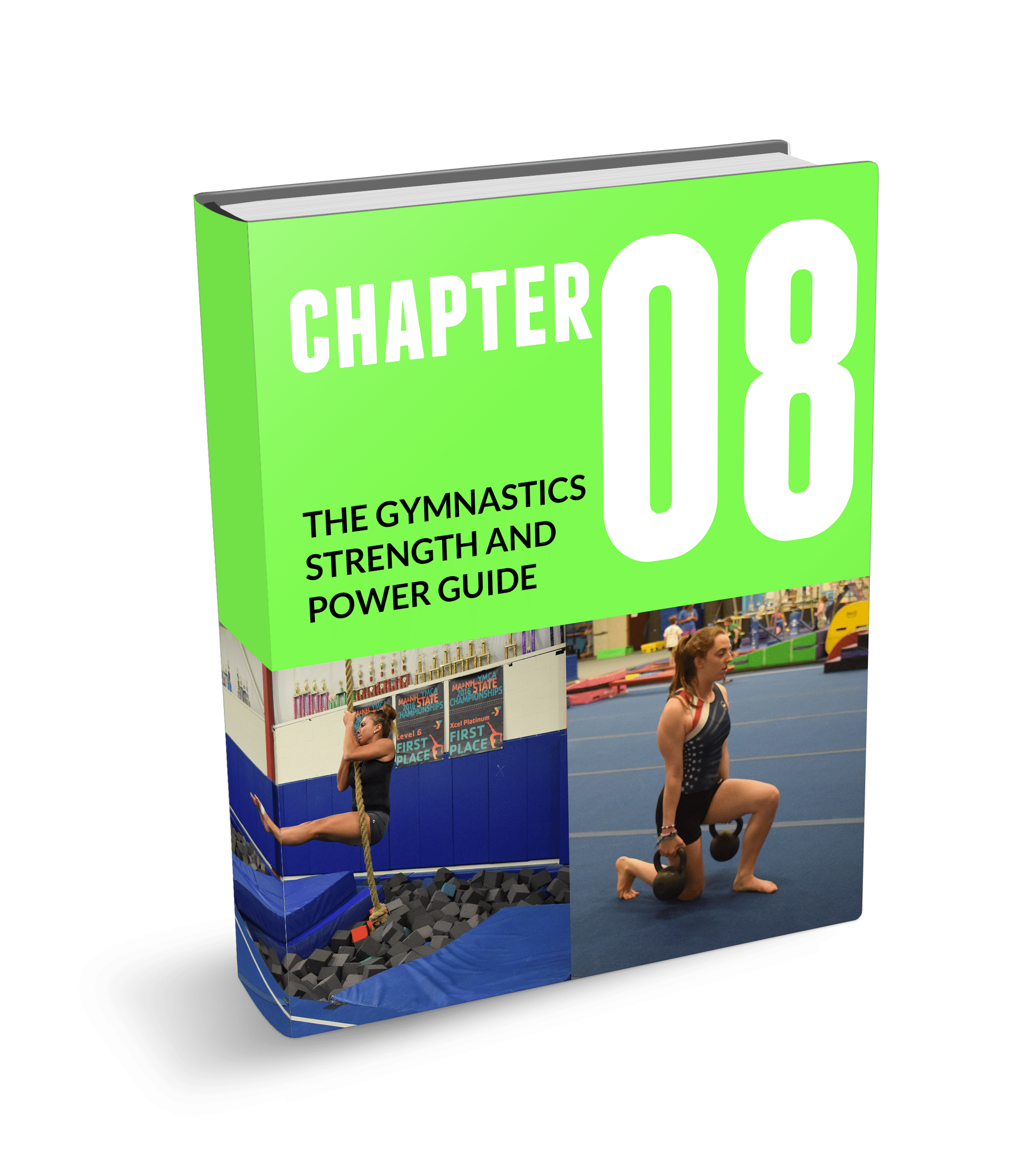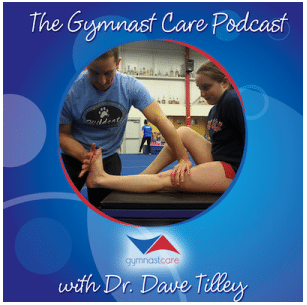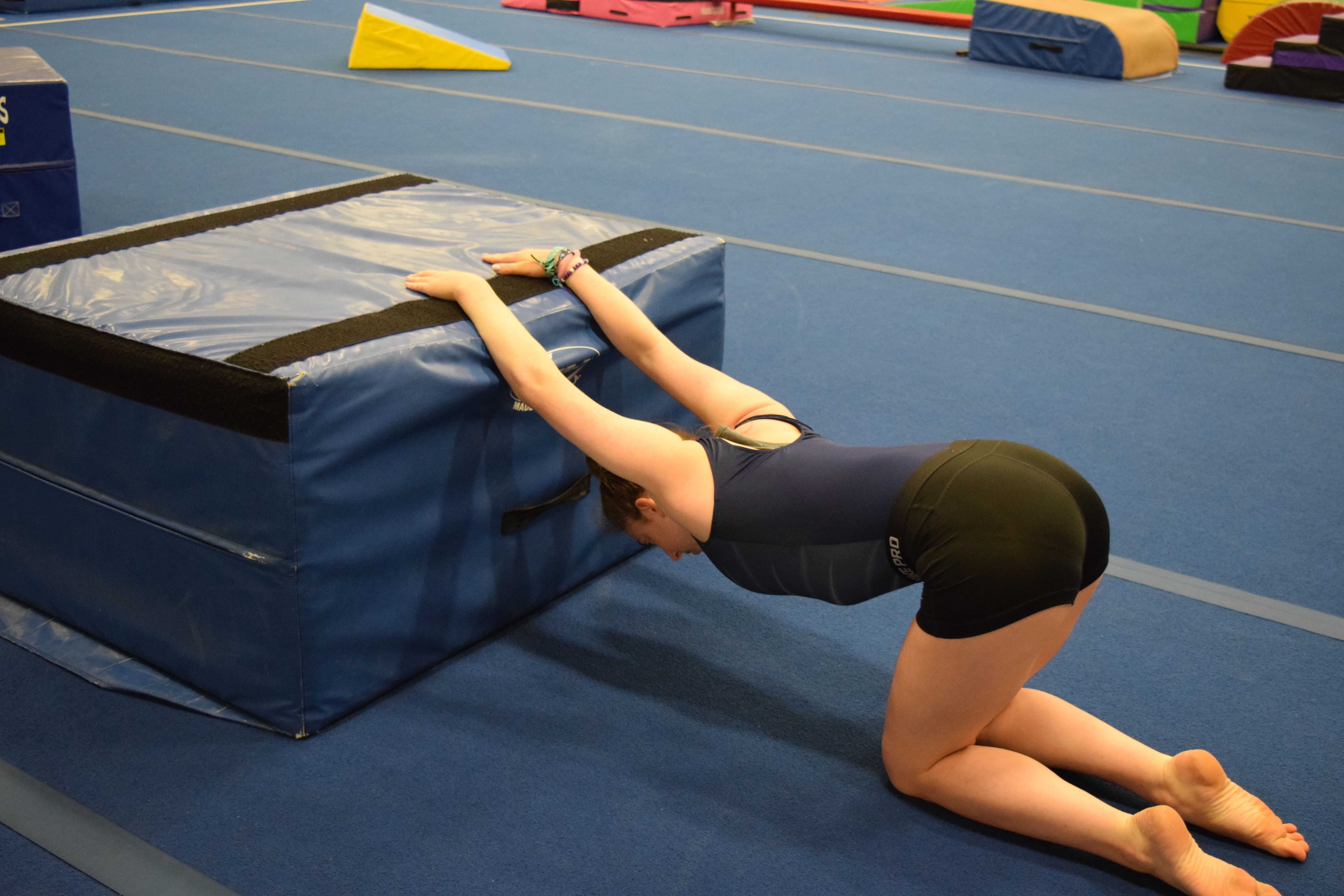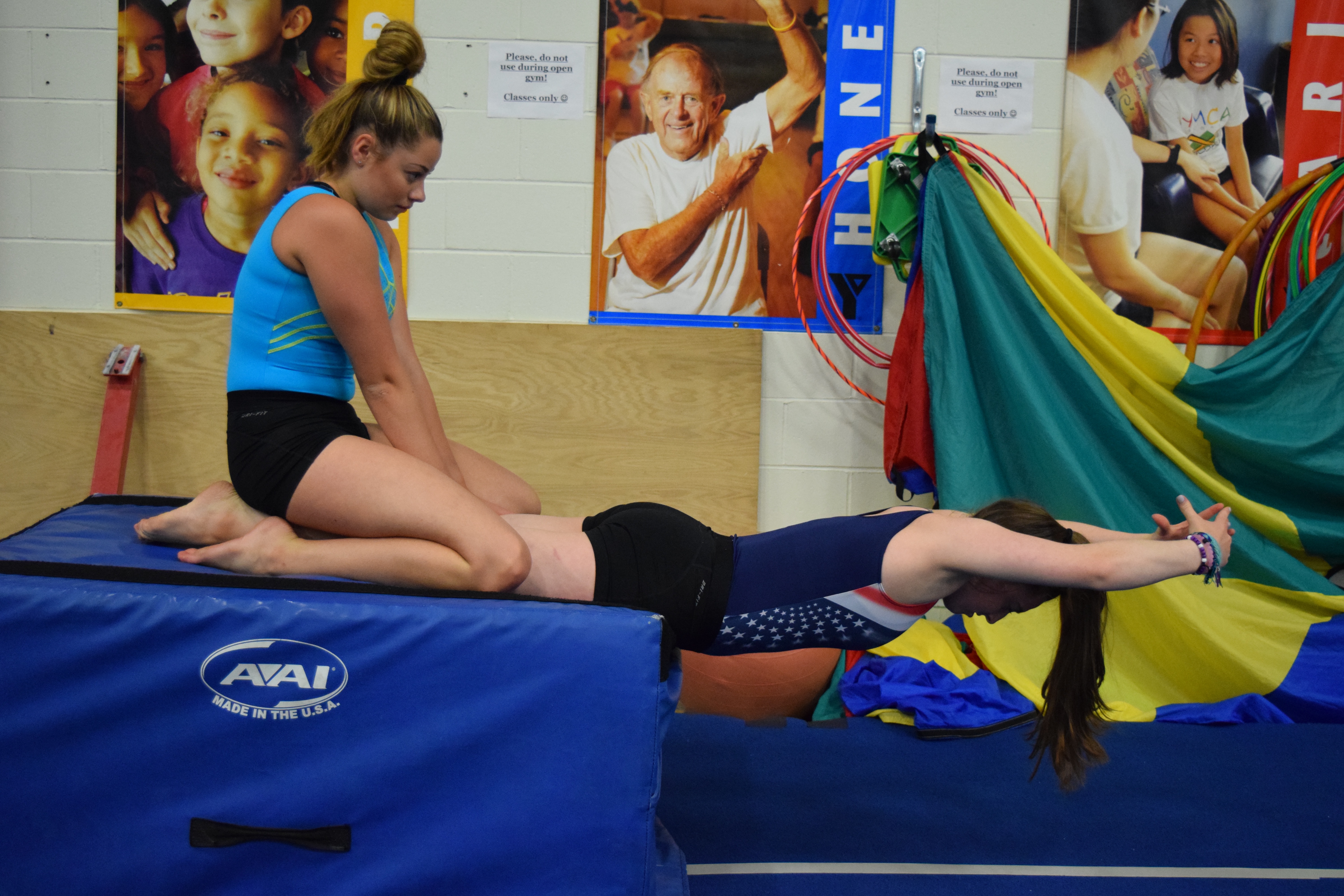Is Arch Up Type Conditioning Contributing To Back Pain In Gymnasts?
I did them growing up..arch ups, uppers, lowers, back extensions hanging over blocks, you name it. As a coach, I also had a lot of my girls do it just going on what I learned. Stuart McGill’s work has been out for some time now, and based off it I have drastically reduced the amount of back extension strength our girls do, and have focused more on spinal stability exercises, recent concepts in the rehab/sport performance world, and Stuart McGills recommendations. I read through pieces in grad school, but after re-reading the information and working with gymnasts more it made me start to connect the dots a bit. This post will probably shake a few cages, but that’s okay.
Before offering more information, remember that you can learn all about Gymnastics Strength and Conditioning for free in my online ebook

The Gymnastics Strength
and Power Guide
- Methods and exercises for increasing strength and power in gymnasts
- Explanations on why gymnasts should use both weight lifting and body weight strength
- Teaches concepts of planning, specific sets or reps, and planning for the competitive year
We take our privacy seriously and will never share your information. Click here to read our full privacy policy.
I’ll share some information from Stuart McGill and Dennis Caine’s work, then make some links about where my thought process has gone.
- Based on McGills work, upper body extension exercises (like a gymnast laying over the edge of a spotting block, a partner holding their legs, and them extending up) puts 4000N (1000lbs) of compression forces on the extended spine with each rep due to muscular co contraction shown through EMG models.
- Arch up/Super man exercises place even more compression force on the spine, with EMG studies showing 6000N (1400 lbs) when performed.
For those non mathy people out there, that is a TON of compression force that can be quite harmful on the spine over time. These forces jump even higher when external loads like weights are applied. Stuart McGill even goes on to say,
“This results in over 6000N of compression to a hyper extended spine, transfers load to the facet (lower spine joints), and crushes the interspinous ligament. Needless to say, this exercise is contraindicated for anyone at risk of a low back injury! This exercise should not be done in any form.”
That literally blew my mind when I read it. Not to mention, I almost started to sweat thinking about how many arch ups I did in my career of gymnastics. I think this is serious for gymnasts and coaches to consider. I absolutely do not think we should stop using the arch position in gymnastics, it is a basic shape that is vital to gymnastics development and performance. Mastering a tight arch is needed for all gymnasts, but thinking about it as a global arch (butt squeeze to hip extension, middle spine and shoulder complex motion) rather than just pure lower back extension (many gymnasts default mode) is more what I’m referencing. I think many coaches teach this really well, but many gymnasts also might be just going to their lower back as the biggest spot of motion which isn’t ideal.
Also, clearly we need a good balance of strength and control across the entire lower back. McGill notes that although some of this type of work may be beneficial, too much can lead to back trouble and should be cautioned. Finding ways to strengthen the entire core unit while sparing the spine and use good motor control is one of his keys to performance. I don’t want people to take this post as me never letting a gymnast do arching movements in the gym, because it’s part of our sport training as a whole.
I do think we need to rethink about how we may use these type of drills though. Considering some of these findings and thinking about what back exercises we make our gymnasts do during training is important.It really made me start to think about how much lower back strength we should train for our gymnasts versus focusing on drills that promote whole core strength through gymanstics skills. Also, that core control and endurance should be more where we’re heading rather then building straight up back extension strength (also supported by McGillls work). Core Control in extension and global core function with endurance and proper stability may lead us to better performance with tumbling and better lower back protection, no perfect answer but it’s good food for thought. Also, since tight lower back muscles are already a huge problem relating to poor core control and increased lower back arches through gymnastics, it may make sense that we don’t want to tighten these muscles more. Don’t take this post the wrong way, it is simply to make people think.
Through his work Stuart McGill highlighted many other exercises like the bird dog (where I got it from and why I use it so much) that spare the spine of compressive loading but still activate musculature. He also presents a lot of other great progressions for lower back strengthening that spares the spine of high compression forces like properly done plank work, certain stability ball exercises, weight/kettle bell work, and more based off his many years of work in this field. Readers might be amazed to know that in a study done by Durall, a pre-season lumbar stabilization program (off of Stuart McGill’s work) helped a college gymnastics squad avoid new back pain cases. There are tons of confounding variables that go into that statement (training, coaching techniques, volume of training, technique, etc.), and it can’t be concluded that the program was the direct reason for decreased rates of lower back pain injuries during the season (although it is “encouraging” according to the authors). It was also a very small group of 15 gymnasts, but still worth mentioning. There is also a discussion to be had about the use of static endurance exercises when a gymnast shows appropriate control, and some other topics related to this.
Many gymnastics gyms have this type of work down pat which is great, making sure technique as a priority is crucial though. More on that to come down the road. From The Sports Medicine Handbook, here are some study findings regarding gymnastics and lower back pain.
- In a study following high level gymnasts 10 years after they had finished gymnastics, 90% of the male and female subjects reported suffering from moderate to severe disorders of the spine.
- A 2005 study by Brueggermann followed 37 gymnasts over a 3 year period to look at structural changes of the spine, 27 of them (62%) showed notable damaging changes of the middle and lower spine from cumulative and repetitive loading
In Stuart McGills book, he proposes the theory that gymnasts may be so fit and strong when they are participating in gymnastics they don’t feel the full severity of the problems. This seems to line up perfectly in a post I talked about last month (click link to find article), where one of my gymnasts had no pain in her lower back despite having an underlying lower back fracture. I also think this is where the faulty “no pain no gain” mentality gets used in gymnasts along with a bit of an ego problem, leading to cumulative back injuries. Not to mention, I know there are tons of factors (training schedules, technique, equipment, the code, coaching, progressions, and many more) that go into this concept that have to be considered. Stuart McGill, the research in Dennis Caine’s book, and my experience with gymnastics all has suggested this is why we need to think about what we give as exercises. This is also a huge component to why I stress core control work and pre-hab techniques in our training for all our gymnasts in an effort to possibly reduce the injury risk. Stuart McGill and Dennis Caine’s work support that the majority of lower back injuries are cumulative in nature, resulting from repetitive trauma with end range loading and technique/motor control errors. Take into consideration these numbers,
- Compression forces at the junction between the lowest spine joint and sacrum (L5/s1) has been measured up to 11.6x body weight with shear forces of 3.5 times body weight
- Gymnastics subjects the lower back to high forces with take off (4x body weight) and landings (11-17x body weight), this is also supported by Dr. Sands work.
- Jumping and landing in a drastic hollow (spine flexed) or excessive arch (spine extended) can abnormally load certain tissues and also compromise the ability of the core muscles to protect the lower spine
All these things came together for me to be eye opening, but did lead me to think about ways we can reduce injury and help our gymnasts stay safe during training. Granted there is no way to prevent every case, I think this is a place to start in creating discussion. Remember, all research comes with it’s own issues so take it with a grain of salt. By no means the golden rules.
This Isn’t Meant To Scare Everyone!
Again, this post is not meant to horrify everyone and make them not go to practice. It is simply to raise awareness about what may be contributing to some of the lower back problems that are so rampant in gymnasts so that we can be pro active about injury. Although it seems like I’m dark and gloomy, there is a lot that can be done to reduce loading overtime. Also, I know there is a ton more to this topic than arch ups that I could spend days writing about. I have just spend quite a bit of time in this area recently and wanted to share some info. As a parting note all of this information made me think that,
- We may want to limit the amount of arch ups/uppers/lowers, etc we give to gymnasts and focus on exercises less demanding on an extended spine such as neutral spine plank work, dynamic core movements with neutral spine focus like dead bugs, and alternative types of conditioning with proper technique. More on this to come
- We should put more focus on teaching athletes to fire from their hips, middle spine, and shoulders rather than their lower back to reduce forces during extending skills. The hips and shoulders are build as power houses, using them on a stable core base can be extremely effective for gymnastics performance.
- We should be proactive about weak and underutilized glute muscles in gymnasts (very common). Everyone has gotten the famous side butt cramp right? This suggests an under developed, and easily fatiguable glute medius and minimus that need attention. Underuse of glute max, with overuse of hamstrings and lower back is common as well. These muscles are crucial to proper hip stability and power for gymnastics skill work.
- Training neutral spine techniques and proper jumping landing mechanics regularly to reduce forces through the lower spine, especially in our younger developing athletes who can develop the proper movement patterns early. Lectures from congress (Ivan Ivanov) on bounding front tumbling and front twisting also suggests good straight/hollow shapes rather than huge aches. Good food for thought in this conversation.
- Perform regular pre-hab for hip and middle spine mobility, as well as overhead shoulder blade stability to reduce compensatory motion at the lumbar spine during global extension movements. I believe working this and reducing the stress across thousands of repetitions for gymnastics skills can go a long way in how much cumulative stress the lower spine takes
- Monitor, correct, and train gymnasts who bend or hinge from their lower back automatically, or standing in improper arch back posture chronically in an effort to reduce the forces through the spine.
McGill is renowned for his work in lower back pain, and has a very scientific in depth approach to analyzing forces that go through the spine contributing to back problems. It’s beyond the scope of this article , but his work has a very complex scientific support to it. He even mentions cases and examples with gymnasts he has worked with for their lower back troubles. He has more work related to the concern with sit ups and improperly done hanging leg raises, but I didn’t want to dive into those. Like I said, not meant to be the debbie downer in gymnastics, just trying to shed light on some ways we can reduce injury risk while also increasing performance. More cool stuff down the road. Check out the references below if your interested in the work. Best of luck,
Dave
References
- Caine D., et al. The Handbook of Sports Medicine In Gymnastics. First Edition. John Wiley and Sons, 2013
- McGill, S. Lower Back Disorders. Second Edition. Human Kinetics, 2007
- McGill, S. Ultimate Back Fitness and Performance: Fifth Edition. BackFitpro, Inc. 2014
- Durall, J., Undermann, B.E., Johansen, D.R., Gibson, B., Reineke, D.M., Reuteman, P., (2009). The effects of preseason trunk muscle training on low back pain occurrence in women collegiate gymnasts, J. Strength and Conditioning Res., 23(1): 86-92









